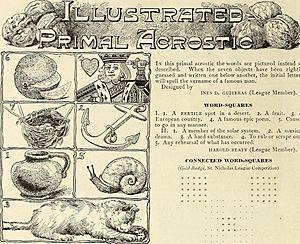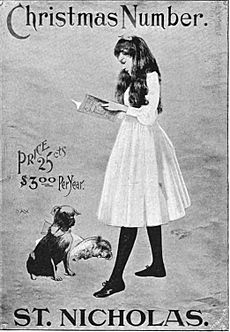St. Nicholas (magazine) facts for kids

St. Nicholas, 1896
|
|
| Categories | Children's |
|---|---|
| Founder | Roswell Smith and Mary Mapes Dodge |
| First issue | November 1873 |
| Final issue | 1943 |
| Country | United States |
| Based in | New York City |
| Language | English |
| OCLC | 1764817 |
St. Nicholas Magazine was a super popular monthly magazine for kids in America. It was started by a company called Scribner's in 1873. The first editor was Mary Mapes Dodge. She worked with the magazine until she passed away in 1905.
Mary Mapes Dodge published stories and poems by many famous writers. These included Louisa May Alcott, Frances Hodgson Burnett, and Mark Twain. Many well-known writers got their start in a special part of the magazine called St. Nicholas League. This section gave awards and cash prizes to young readers for their best work. Famous people like Edna St. Vincent Millay, F. Scott Fitzgerald, and E. B. White were all winners in the St. Nicholas League.
St. Nicholas Magazine stopped being published in 1940. There was an attempt to bring it back in 1943, but only a few issues came out before it closed down for good.
Contents
How St. Nicholas Began
In 1870, Roswell Smith, who helped start Scribner & Company, reached out to Mary Mapes Dodge. He wanted to know if she would be interested in working on a new children's magazine. At that time, Dodge was an editor for a weekly paper called Hearth and Home. She also wrote popular children's books, like Hans Brinker, or The Silver Skates.
Mary Mapes Dodge had clear ideas about what a children's magazine should be. She believed it needed to be strong and honest, not just a simple version of adult magazines. She felt that after school, kids didn't want to be "bothered" or "amused." They just wanted to enjoy their own magazine in their own way.
The first issue of St. Nicholas: Scribner's Illustrated Magazine for Girls and Boys came out in November 1873. It had 48 pages and printed 40,000 copies. While St. Nicholas didn't have as many readers as some other magazines, it quickly became very popular.
Over the years, St. Nicholas took over several other children's magazines. These included Our Young Folks and The Children's Hour in 1874. Later, The Schoolday Magazine, The Little Corporal, and Wide Awake also joined St. Nicholas.
From the very beginning, St. Nicholas was known for its beautiful printing. It featured amazing illustrations from artists and engravers who also worked for Scribner & Company's other magazine, Scribner's Monthly.
The St. Nicholas League
In 1899, the St. Nicholas League began. This became one of the magazine's most important sections. Its motto was "Live to learn and learn to live."
Every month, the League held contests for young readers. Kids could submit their best poems, stories, essays, drawings, photographs, and puzzles. Winners received gold badges, and runners-up got silver badges. "Honor members," who won both gold and silver badges, even received cash prizes.
Many winners of the St. Nicholas League later became very famous. The poet Edna St. Vincent Millay had seven of her poems published in the League. E. B. White and Bennett Cerf won essay contests. William Faulkner was recognized for his drawings, and F. Scott Fitzgerald was honored for a photograph.
Key People Behind the Magazine
Mary Mapes Dodge as Editor
From 1873 to 1881, Mary Mapes Dodge was deeply involved in every part of St. Nicholas. She created different sections for the magazine. She also wrote a monthly column called "Jack-in-the-Pulpit" and contributed many stories and poems herself.
In the very first issue, she explained why she chose "St. Nicholas" for the magazine's name:
- Is he not the boys' and girls' own Saint, the especial friend of young Americans?... And what is more, isn't he the kindest, best, and jolliest old dear that ever was known?... He has attended so many heart-warmings in his long, long day that he glows without knowing it, and, coming as he does, at a holy time, casts a light upon the children's faces that lasts from year to year.... Never to dim this light, young friends, by word or token, to make it even brighter, when we can, in good, pleasant helpful ways, and to clear away clouds that sometimes shut it out, is our aim and prayer.
To keep young readers interested for many years, Dodge created sections for different age groups. "For Very Little Folks" (1873–1897) had simple stories printed in large letters. The "Puzzle Box" offered riddles and games. The "Young Contributors Department" (started in 1875) helped older children improve their writing. The "Agassiz Association" began in 1885 to teach kids about nature and why it's important to protect it. Hundreds of Agassiz groups formed across the country, and their activities were shared in the magazine.
Dodge knew many famous writers and convinced them to write for her magazine. Frances Hodgson Burnett's novel Little Lord Fauntleroy first appeared in St. Nicholas as a series. Her story Sara Crewe also appeared there. Other famous novels serialized in St. Nicholas included Louisa May Alcott's Eight Cousins and Mark Twain's Tom Sawyer Abroad. Dodge even asked Rudyard Kipling for stories, and he sent her the Jungle Book tales.
Within a few years, St. Nicholas grew to 96 pages. It reached 70,000 subscribers.
In 1881, the Scribner publishing company sold its magazines. St. Nicholas was bought by The Century Company. The magazine continued to do well with its new owner.
After her eldest son, Harry, passed away in 1881, Mary Mapes Dodge gave more of her duties to her assistant editor, William Fayal Clarke. Even though she wasn't in charge of everything day-to-day, Dodge continued to work at St. Nicholas until her death in 1905.
William Fayal Clarke as Editor
William Fayal Clarke was twenty years old when he joined St. Nicholas in 1874. In 1878, he became an associate editor. Starting in 1881, he took on more responsibilities when Mary Mapes Dodge reduced her workload.
As editor, Clarke focused more on adding new departments. He might have done this because he didn't have the same close connections to famous authors as Dodge did. Sections about short plays, science, and philately (stamp collecting) were added to St. Nicholas. The number of readers stayed around 70,000.
In 1927, Clarke stepped down as editor. He retired in 1928, after working for the magazine for 54 years. After he left, St. Nicholas began to lose readers.
The Magazine's Last Years
In November 1927, George F. Thomson became editor. He was replaced after two years, and many different editors took over quickly after that.
In 1930, St. Nicholas was sold to American Education Press. Its full name changed to St. Nicholas for Boys and Girls. In 1935, it was sold again to Educational Publishing Corporation.
Editors during these last years included Albert Gallatin Lanier, May Lamberton Becker, Eric J. Bender, Chesla Sherlock, Vertie A. Coyne, and Juliet Lit Sterne.
In 1940, the magazine's look changed. It became a large-print picture and story magazine for young readers. The shiny paper was replaced with soft paper. The last issue came out in February 1940.
St. Nicholas was brought back for a short time with a March 1943 issue. It had a similar look to its early days. Juliet Lit Stearns owned and edited it, with F. Orlin Tremaine as business manager. However, it closed down again after only four issues.
Finding Old Issues and Stories
St. Nicholas offered a special service to its readers. For a small fee, six issues could be bound together into a hard-back book. These books had red covers and a gold title. You can still find these bound volumes from used book sellers today.
Many collections of favorite St. Nicholas stories have been put together. Two of the most famous collections were edited by Henry Steele Commager and published by Random House. The head of Random House, Bennett Cerf, had actually been a St. Nicholas reader and contributor to the St. Nicholas League when he was young. The St. Nicholas Anthology came out in 1948, followed by The Second St. Nicholas Anthology in 1950.
In 2003 and 2004, William F. Buckley Jr. also edited two collections of classic children's literature from St. Nicholas stories.
You can even download some St. Nicholas issues for free online. Websites like Project Gutenberg offer them.
See also



